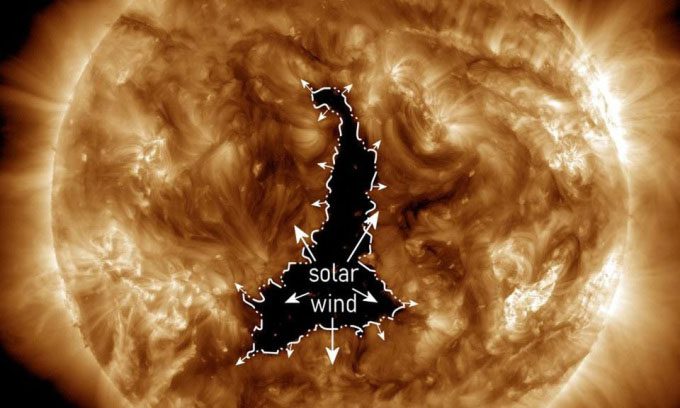A massive dark region approximately 800,000 km wide, known as a coronal hole, has formed near the Sun’s equator, emitting streams of radiation towards Earth.
A dark area resembling a black hole has appeared on the surface of the Sun, releasing solar wind—fast and powerful streams of radiation—directly towards Earth. This temporary black hole is called a coronal hole, and it is over 60 times the size of Earth. Scientists have never observed a coronal hole of this size and orientation at this stage of the solar cycle. It formed near the Sun’s equator on December 2 and reached a maximum width of about 800,000 km within 24 hours. Since December 4, this black hole has been directed straight towards Earth.

A massive dark coronal hole emitting solar wind. (Photo: NASA/SDO/AIA).
Initially, experts predicted that this new black hole could produce a moderate geomagnetic storm, level G2, capable of causing radio signal disruptions and creating strong auroras in the following days. Ultimately, the solar wind was not as strong as anticipated, leading to a weaker G1 storm classification; however, auroras could still be visible in higher latitude areas.
It remains uncertain how long this new coronal hole will last, but previous holes have persisted longer than one solar rotation (27 Earth days), according to the National Oceanic and Atmospheric Administration (NOAA). Nevertheless, the new coronal hole will soon rotate away from Earth.
Coronal holes appear when the Sun’s magnetic field suddenly opens up, causing materials on the Sun’s surface to be expelled as solar wind. Coronal holes appear as dark patches because they are cooler and less dense than the surrounding plasma. This is similar to why sunspots appear black, but unlike sunspots, coronal holes cannot be seen without ultraviolet light observation.
The radiation streams from coronal holes are much faster than regular solar wind and have previously caused disturbances in Earth’s magnetic field, known as geomagnetic storms, according to NOAA. The most recent coronal hole appeared on the Sun in March and generated the strongest geomagnetic storm to reach Earth in six years.
Solar activity is increasing as the Sun approaches the peak of its 11-year cycle, known as solar maximum. However, experts do not believe that the new coronal hole is part of this increase in activity.
According to NOAA, coronal holes can appear at any time during the solar cycle, but they are often more common during solar minimum. When they occur during solar maximum, they typically appear near the poles rather than the equator. Therefore, the emergence of such a large hole near the equator as the Sun approaches solar maximum is puzzling to scientists.





















































